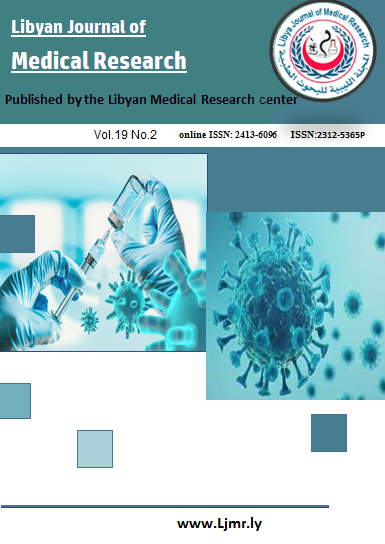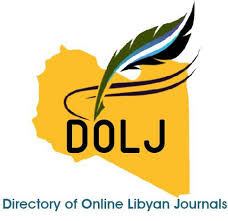Synthesis of 3-hydroxy-4-{[(2E)-2-(hydroxyimino)ethylidene]amino}-naphthalene-1-sulfonic acid for Complex formation of Cr3+, Co2+, Ni2+ and Cu2+ ions
DOI:
https://doi.org/10.54361/LJMR.19.2.16Keywords:
4-(2-hydroxbenzylideneamino)-3-hydroxnaphtalene-1-sulfonic acid, Pathogenic bacteria, Schiff-base complexes.Abstract
Purpose: This study aimed to synthesize and characterize new Schiff-base complexes derived from 3-hydroxy-4-{[(2E)-2-(hydroxyimino)ethylidene]amino}-naphthalene-1-sulfonic acid and to evaluate their structural properties and antimicrobial activity. Materials and Methods: The complexes of Cr³⁺, Co²⁺, Ni²⁺, and Cu²⁺ were synthesized and characterized using IR spectroscopy, molar conductivity, UV-Vis spectroscopy, magnetic susceptibility measurements, and elemental analysis (C, H, N, and S). The coordination behavior of the ligand was investigated based on spectral and magnetic data. Results: Elemental analysis confirmed a 1:1 metal-to-ligand stoichiometry in all complexes. Molar conductivity values indicated that the complexes are non-electrolytic. Magnetic moment data revealed that the Ni²⁺ complex is diamagnetic, while Co²⁺, Cr³⁺, and Cu²⁺ complexes are paramagnetic. IR spectral data suggested coordination through the hydroxyl and imino groups. Electronic spectra showed n→π* and π→π* transitions, supporting octahedral geometry for all complexes. Conclusion:The structural analysis confirmed the formation of stable, octahedral Schiff-base metal complexes. These compounds, including the free ligand, demonstrated notable antimicrobial activity against pathogenic bacteria such as Proteus, Bacillus subtilis, Staphylococci, and Pseudomonas aeruginosa.
Downloads
References
1. Elmagbari, Ahmed N. Hammouda, Hamdi A. M. Bennour, Rashd M. EL-Ferjani, Younis O. Ben Amer, Synthesis and Characterization of Cr(III) and Co(II) Schiff Base Complexes, Materials Sciences and Applications,) 2023(, 14, 53-62.
2. Shinky Mehta, Sanjiv Kumar, Rakesh Kumar Marwaha, Balasubramanian Narasimhan, Kalavathy Ramasamy, Siong Meng Lim, Syed Adnan Ali Shah and Vasudevan Mani, , Synthesis, molecular docking and biological potentials of new 2-(4-(2-chloroacetyl) piperazin-1-yl)-N-(2-(4-chlorophenyl)- 4-oxoquinazolin-3(4H)-yl)acetamide derivatives, Mehta et al. BMC Chemistry, )2019(, 13:113, 1-22.
3. R. B. Sumathi and M. B. Halli, Metal (II) Complexes Derived from Naphthofuran-2-carbohydrazide and Diacetylmonoxime Schiff Base: Synthesis, Spectroscopic, Electrochemical, and Biological Investigation, Hindawi Publishing Corporation Bioinorganic Chemistry and Applications )2014(, 1-11.
4. Abdulsalam Hamil, Khalifa Mosbah Khalifa, Arabya Abdelsalam Almutaleb, Mariam Qasim Nouradean, Synthesis, Characterization and Antibacterial Activity Studies of Some Transition Metal Chelates of Mn(II), Ni(II) and Cu(II) with Schiff Base Derived from Diacetylmonoxime with o-phenylenediamine, Advanced Journal of ChemistrSection A, )2020(, 3(4), 524-533.
5. Hasan. A. Hasan, B.M. Sarhan, W. M. Alwan, Synthesis, Characterization and Biological Activity of Azo-linked Schiff Base Ligand Type (ONO) and its Complexes with CrIII, MnII and FeII Ions, Al- Mustansiriyah J. Sci., )2013(, 24, 6, 1-16.
6. Bharat A. Makwana, Pratik N. Dave, Pratik B. Timbadiya, synthesis of Schiff bases and their transition metal complexes characterization & application, International Journal of Science, Technology & Management, )2015(, 04( 01), 642-652.
7. A.M. Hamil, K. M. Khalifa, S.A. Mukhtar, Y.A. Alkhayali, S.A. Saad, Complex formation of Cr3+, Co2+, Ni2+ and Cu2+ ions using 4-(2hydroxbenzylideneamino)-3-hydroxnaphtalene-1-sulfonic acid, Mansoura Journal of Chemistry, )2015(, 43-55.
8. Elias Assayehegn , Abraha Tadese , Goitom G/Yohannes , Samuel Alemayehu and Tesfamariam Teklu, Synthesis, Physicochemical, and Antimicrobial Activity of Copper and Zinc Complexes with N, O - Bidentate Schiff Base, Momona Ethiopian Journal of Science (MEJS) , )2023( , 15(1): 32-47.
9. Hiyam Hadi Alkam , Rehab K. Al-Shemary, Microwave Synthesis Schiff Base from Drug and 1,10- Phenanthroline/8-Hydroxyquinoline as a Coligand with Complexes: Cytotoxic, Antimicrobial, and DNA Interaction Efficacy, Journal of Medicinal and Chemical Sciences) 2022(, 5 1331-1346.
10. M.M EL-Ajaily and F.M.E1.Saied syntheies and characterizasion of urea scheff base chelatas of Cr(iii), Cr(vi),Tio(iv) and Pb(ii); Asian J.chem (2007), 9(6), 4433,4437.
11. K.Mounika, B. Anupama , J. Pragathi, and C. Gyanakumara , Synthesis¸Characterization and Biological Activity of a Schiff Base Derived from 3-Ethoxy Salicylaldehyde and 2-Amino Benzoic acid and its Transition Metal Complexes. J. Sci. Res. (2010), 2 (3),513-524.
12. Anil Kumar M.R, Shanmukhappa, S, Rangaswamy B. E, Revan-asiddappa M.; Synthesis, Characterization, Antimicrobial Activity, Antifungal Activity and DNA Cleavage Studies of Transition Metal Complexes with Schiff Base Ligand, International Journal of Innovative Research in Science, (2015), 4 (2), 60-66.
13. Md. Rabiul Hasan, Mohammad Amzad Hossain, Md. Abdus Salam, Mohammad Nasir Uddin, Nickel complexes of Schiff bases derived from mono/diketone with anthranilic acid: Synthesis, characterization and microbial evaluation, Journal of Taibah University for Science, (2016), 10, 766–773.
14. Raafat M. Issa, Abdalla M. Khedr and Helen Rizk , 1HNMR, IR and UV/VIS Spectroscopic Studies of Some Schiff Bases Derived From 2-Amino benzothiazole and 2-Amino-3-hydroxy pyridine, Journal of the Chinese Chemical Society, (2008), 55, 875-884.
15. Tarek M.Ismail, Mosad A. ELGhamry, Samy M. Abu-El-Wafa, DoaaF. Sallam, Synthesis,Characterization, D Modelling, Biological Activities of Some Metal Complexes of Novel Sulfa Drug Schiff Base Ligand and Its Nano Cu Complex, Modern Chemistry, (2015), 3(2), 18-30.
16. Pandya JH, Jadeja RN, Ganatra KJ. Spectral characterization and biological evaluation of Schiff bases and their mixed ligand metal complexes derived from 4,6-diacetylresorcinol. J Saudi Chem Soc. 2014;18(3):190–9.
17. Elham Pahlavani; Hadi Kargar ; Nahid Sepehri Rad, A Study on Antitubercular and Antimicrobial Activity of Isoniazid Derivative, Zahedan J Res Med Sci. (2015) , 17(7),1010.
18. Maged S. Al-Fakeh, Synthesis, thermal stability and kinetic study of Copper(II) and Cobalt(IIcomplexexs derived from 4-amino benzo Hydrazide and 2- mercaptobenzothiazole, Eur. Chem. Bull., (2020), 9(12), 403-409.
19. B.H.M. Mruthyunjayaswamy, Omkar B. Ijare and Y. Jadegoud, Synthesis, Characterization and Biological Activity of Symmetric Dinuclear Complexes Derived from a Novel Macrocyclic Compartmental Ligand, J. Braz. Chem. Soc., (2005), 16(4), 783-789.
20. Adem Cinarli , Demet Gürbüz , Aydin Tavman, A. Seher Birteksöz, Synthesis, Spectral, Characterizations and Antimicrobial Activity of Some Schiff Bases of 4-Chloro-2-Aminophenol, Bull. Chem. Soc. Ethiop. (2011), 25(3), 407-417. 21.Kannappan, R.; Mahalakshmy, R.; Rajendiran, T. M.;Venkatesan, R.;
21. Sambasiva Rao, P. Proc. Magnetic, catalytic, EPR and electrochemical studies on binuclear copper(II) complexes derived from 3,4-disubstituted phenol; Indian Acad.Sci. (Chem. Sci.), (2003), 115, 1-14.
22. Ibrahim Demir, Mustafa Akkaya, Mevulta Bayrakci A. Ihsan Pekacar, Synthesis and Characterization of Cu(II), Cd(II) and Hg(II) Complexes with Schiff Bases; Asian J. Chem., (2007),19, 3954.
Downloads
Published
Issue
Section
License
Copyright (c) 2025 Sarah A. Mukhtar, Arabya A.A. Almutaleb, Abdusalam M. Hamil , M. Khalifa, Y. A. Alkhayali, Shamsi. A. Saad (Author)

This work is licensed under a Creative Commons Attribution-NonCommercial-NoDerivatives 4.0 International License.
Open Access Policy
Libyan journal of medical Research (LJMR).is an open journal, therefore there are no fees required for downloading any publication from the journal website by authors, readers, and institution.
The journal applies the license of CC BY (a Creative Commons Attribution 4.0 International license). This license allows authors to keep ownership f the copyright of their papers. But this license permits any user to download , print out, extract, reuse, archive, and distribute the article, so long as appropriate credit is given to the authors and the source of the work.
The license ensures that the article will be available as widely as possible and that the article can be included in any scientific archive.
Editorial Policy
The publication of an article in a peer reviewed journal is an essential model for Libyan journal of medical Research (LJMR). It is necessary to agree upon standards of expected ethical behavior for all parties involved in the act of publishing: the author, the journal editorial, the peer reviewer and the publisher.
Any manuscript or substantial parts of it, submitted to the journal must not be under consideration by any other journal. In general, the manuscript should not have already been published in any journal or other citable form, although it may have been deposited on a preprint server. Authors are required to ensure that no material submitted as part of a manuscript infringes existing copyrights, or the rights of a third party.
Authorship Policy
The manuscript authorship should be limited to those who have made a significant contribution and intellectual input to the research submitted to the journal, including design, performance, interpretation of the reported study, and writing the manuscript. All those who have made significant contributions should be listed as co-authors.
Others who have participated in certain substantive aspects of the manuscript but without intellectual input should only be recognized in the acknowledgements section of the manuscript. Also, one of the authors should be selected as the corresponding author to communicate with the journal and approve the final version of the manuscript for publication in the LJMR.
Peer-review Policy
- All the manuscripts submitted to LJMR will be subjected to the double-blinded peer-review process;
- The manuscript will be reviewed by two suitable experts in the respective subject area.
- Reports of all the reviewers will be considered while deciding on acceptance/revision or rejection of a manuscript.
- Editor-In-Chief will make the final decision, based on the reviewer’s comments.
- Editor-In-Chief can ask one or more advisory board members for their suggestions upon a manuscript, before making the final decision.
- Associate editor and review editors provide administrative support to maintain the integrity of the peer-review process.
- In case, authors challenge the editor’s negative decision with suitable arguments, the manuscript can be sent to one more reviewer and the final decision will be made based upon his recommendations.














